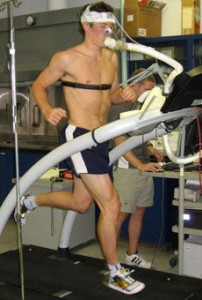On September 26, 2012, I went to USC School of Public Health to be tested for my V02 max. Wikipedia defines V02 max as:

**VO2 max** (also **maximal oxygen consumption**, **maximal oxygen uptake**, **peak oxygen uptake** or **maximal aerobic capacity**) is the maximum capacity of an individual's body to transport and use oxygen during [incremental exercise](http://en.wikipedia.org/wiki/Incremental_exercise), which reflects the [physical fitness](http://en.wikipedia.org/wiki/Physical_fitness) of the individual. The name is derived from V - [volume](http://en.wikipedia.org/wiki/Volume), O2 - [oxygen](http://en.wikipedia.org/wiki/Oxygen), max - maximum.
Basically it represents your peak oxygen uptake, ie, your ability to deliver oxygen to your muscles. My test lasted for 10:30 before I tapped out and stopped. When you first start, you’re hooked up to a machine that measures your oxygen. You also wear a heart rate monitor and have your blood pressure taken at regular intervals. To help the test go faster, the treadmill you run on is set to a higher incline. Here’s a photo of what the set up looks like.
I’ve included a scan of my test results below. Here’s the interpretation of what you are reading:
Cardiorespiratory fitness determines your ability to perform moderate-to-high intensity activities for prolonged periods of time. Your cardiorespiratory fitness was measured by collecting your expired air while you performed a maximal exercise test (treadmill test) and determining the volume of oxygen (VO2) you were able to use at your maximum effort. Along with the following variables, we also calculated your anaerobic threshold. This denotes the point at which the exercise you are doing goes from being aerobic (like jogging or cycling) to anaerobic exercise (like a sprint). Most individuals try to train at, or just above/below, this threshold to increase their aerobic performance. We have provided your heart rate and oxygen consumption at this threshold to allow you to monitor your training and try and improve your performance.
Your results are as follows:
-
Maximal Heart Rate: 165 bpm
-
Maximal Oxygen Consumption: 23.1 ml/kg/min
-
Heart Rate at the Anaerobic Threshold: 153 bpm
-
Oxygen Consumption at the Anaerobic Threshold: 19.3 ml/kg/min
-
Treadmill Time: 10:30
For someone who is 30 years old, anything below a V02 max norm of 30 is considered to be very poor. What does that mean for me? There is plenty of room for improvement! Now that I have these figures, I can start training on increasing my V02 max. One of the best ways to do this is with intervals, running hills and continuing to hit the bike and the gym on a daily basis. Some other options include wearing a high altitude training mask that simulates training at up to 18,000 feet.
Personal note: When I first saw these results, I got down on myself. I thought that I was in good physical condition, but then I remembered how far I’ve come in my weight loss journey in the past year. It will take a while until I’m in a good fighting shape and I will never give up on that goal. Now we have a baseline. Is it the best? No, but it’s a starting point and that’s what matters. The next test that I’m up for is a full checkup and a thyroid test. After that I will be exploring options of visiting a specialist to have a stress test for my heart done. The last thing we want to happen is something bad on race day because I was not prepared.
